The following high-resolution versions of the figures from the
sauropod history paper are for the benefit of scientists. Feel
free to reproduce or modify these for use in scientific
(i.e. peer-reviewed) literature. Please do not reproduce
these in other non-scientific contexts without explicit permission
from the author. (I'll probably give permission, but you need to
check.)
|
Fig. 1.
Historically significant isolated sauropod elements. (a) The holotype
tooth of Cardiodon in labial and distal views, modified from Owen
(1875a, plate IX, figs 2 and 3); (b) anterior caudal vertebra of
Cetiosaurus brevis in anterior view, part of the holotype,
photograph by the author; (c) holotype right humerus
of Pelorosaurus in anterior view, modified from Mantell (1850,
plate XXI, fig. 1b); and (d) lectotype dorsal vertebra
of Ornithopsis (see Blows 1995, p. 188) in anterior view,
exposing pneumatic cavities owing to erosion of the anterior articular
surface, modified from Owen (1875a, plate IX, fig. 1). The scale bar
is 5 cm for (a), 10 cm for (b) and (d), and 30 cm for (c).
|
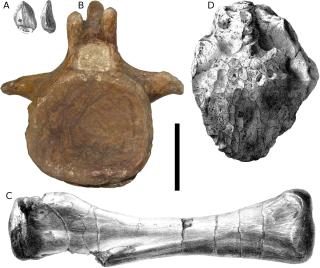
|
|
Fig. 2.
Elements of Cetiosaurus oxoniensis. Top row, left to right:
right scapula in lateral view and left scapula in medial view; right
humerus in anterior and distal views, and left humerus in proximal and
posterior views; left femur in anterior view. Bottom row, left to
right: left coracoid in medial view and ?left sternal plate in ?dorsal
view; right ilium in lateral view and ?fourth dorsal vertebra in
anterior and right lateral views; ?right ulna in ?posterolateral view;
right tibia in proximal and posterolateral views. Dorsal vertebra
modified from Phillips (1871, fig. 86), other elements modified from
Owen (1875b, figs 1 9), which were reproduced from Phillips
(1871). The scale bar is 50 cm.
|
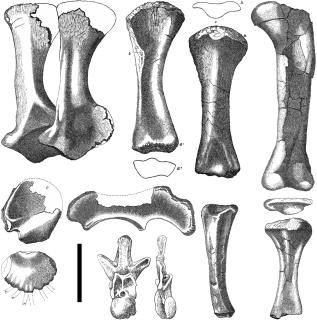
|
|
Fig. 3.
Early reconstructions of Camarasaurus. Top: Ryder's 1877
reconstruction, the first ever made of any sauropod, modified from
Osborn & Mook (1921, plate LXXXII). Bottom: Osborn & Mook's own
reconstruction. modified from Osborn & Mook (1921, plate LXXXIV).
|
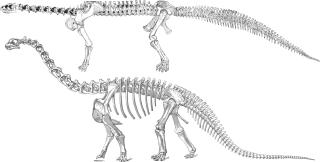
|
|
Fig. 4.
Marsh's reconstructions of 'Brontosaurus'
(now Apatosaurus). Top: first reconstruction, modified from
Marsh (1883, plate I). Bottom: second reconstruction, modified from
Marsh (1891, plate XVI).
|
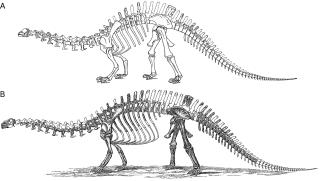
|
|
Fig. 5.
Snorkelling sauropods. Left: the first-ever life restoration of a
sauropod, Knight's drawing of Amphicoelias, published by Ballou
(1897), modified from Osborn & Mook (1921, fig. 127). Right: a similar
scene with 'Helopus' (now
Euhelopus), modified from Wiman (1929, fig. 5).
|
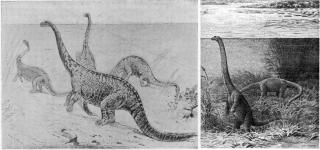
|
|
Fig. 6.
Two classic sauropod paintings by Knight. Left: swamp-bound
'Brontosaurus' (now Apatosaurus), painted in 1897, with
static terrestrial Diplodocus in background. Right: athletic
Diplodocus, painted in 1907.
|
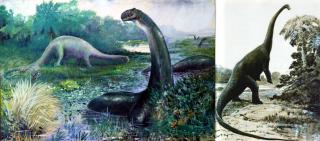
|
|
Fig. 7.
Tornier's sprawling, disarticulated reconstruction
of Diplodocus, modified from Tornier (1909, plate II).
|
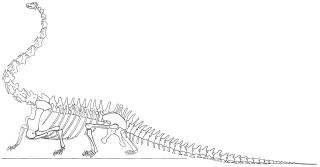
|
|
Fig. 8.
Growing recognition of sauropod diversity through history. Only genera
now considered valid are included. (a) Broken down by clade. The
vertical thickness of the lines is proportional to the number of
genera; the earliest valid genus in each clade is marked by a
circle. Terminal clades have simple counts; for non-terminal clades,
parentheses enclose the number of basal genera, that is, not members
of depicted subclades, and are followed by total counts that include
those of all subclades. (b) Total recognized diversity.
|
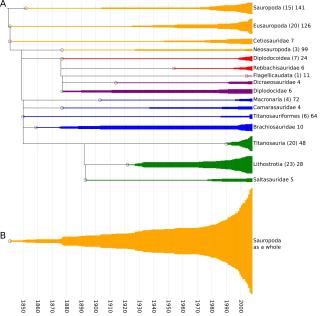
|







